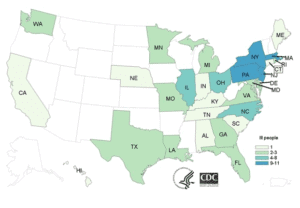Last week’s salmonella outbreak affected 29 states and sickened 92 people, resulting in 21 hospitalizations (no deaths have been reported). These cases mark the 16th salmonella outbreak in 2018, which is twice as many as 2015 or 2016. The current outbreak is courtesy of a strain called Salmonella Infantis and, according to the CDC, appears to be resistant to a multitude of antibiotics, making this strain more resilient. This strain was found in live chickens and in various types of raw chicken products and brands from many different locations, which suggests that this could be a widespread issue in the chicken industry; especially because it is difficult to pinpoint a single, common supplier of chicken where this strain began. The CDC also warns against feeding pets raw chicken as germs in the food can make cats and dogs sick, and individuals can get sick from handling the product.

Most people get sick from salmonella 12-72 hours after ingestion of the bacteria. This strain can cause stomach pain, cramps, diarrhea, and fever lasting up to 72 hours.Individuals typically recover within a week without treatment, though some symptoms may last longer and can be more severe. In rare cases, salmonella infection can cause death unless the person is treated with antibiotics making this strain more concerning because of its multidrug resistance.
In a related and developing story, on Friday, October 19, The US Department of Agriculture Food and Safety Inspection Service (USDA) announced that Bakkavor Foods USA, Inc. is recalling nearly 2.5 million pounds of taquitos due to an onion ingredient. The company has found that the diced onions in their beef and cheese taquitos could be contaminated with listeria monocytogenes and salmonella. This recall is not connected to the salmonella outbreak and no illnesses have been reported.
For prevention against salmonella, you should always wash your hands, especially after preparing food such as raw chicken, as well as wash food preparation areas including knives and cutting boards to prevent cross-contamination. Ensure that raw chicken is cooked thoroughly to an internal temperature of 165°F to kill germs. It is recommended that you should not wash raw poultry before cooking as this may spread germs to other kitchen surfaces.
